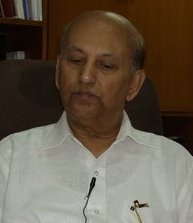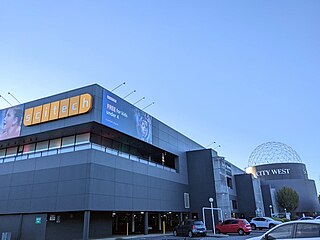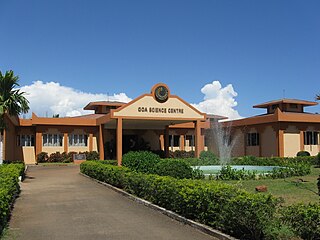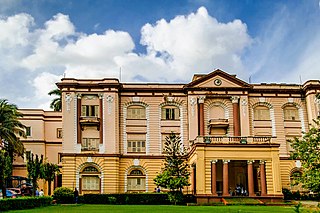
The Visvesvaraya Industrial and Technological Museum (VITM), Bangalore, India, a constituent unit of the National Council of Science Museums (NCSM), Ministry of Culture, Government of India, was established in memory of Sir M. Visvesvaraya. The 4,000 m2 (43,000 sq ft) building was constructed in Cubbon Park, and was inaugurated by the first Prime Minister of India, Pandit Jawaharlal Nehru, on July 14, 1962. The museum displays industrial products, scientific models and engines.

The National Space Centre is a museum and educational resource covering the fields of space science and astronomy, along with a space research programme in partnership with the University of Leicester. It is located on the north side of the city in Belgrave, Leicester, England, next to the River Soar. Many of the exhibits, including upright rockets, are housed in a tower with minimal steel supports and a semi-transparent cladding of ETFE 'pillows' which has become one of Leicester's most recognisable landmarks. The National Space Centre is a registered charity with a board of trustees.

The Indian Space Research Organisation is the national space agency of India. It operates as the primary research and development arm of the Department of Space (DoS), which is directly overseen by the Prime Minister of India while the Chairman of ISRO also acts as the executive of DoS. ISRO is primarily responsible for performing tasks related to space-based operations, space exploration, international space cooperation and the development of related technologies. ISRO is one of the six government space agencies in the world that possesses full launch capabilities, can deploy cryogenic engines, can launch extraterrestrial missions and operate a large fleet of artificial satellites. ISRO is one of the four government space agencies to have soft landing (uncrewed) capabilities.

Udupi Ramachandra Rao was an Indian space scientist and former chairman of the Indian Space Research Organisation. He was also the Chairman of the Governing Council of the Physical Research Laboratory at Ahmedabad and Nehru Planetarium at Bengaluru and chancellor of the Indian Institute for Space Science and Technology (IIST) at Thiruvananthapuram. He is known as "The Satellite Man of India". He pioneered India's first satellite launch Aryabhata in 1975.

Telus World of Science Edmonton (TWOSE) is a broad-based science centre in Edmonton, Alberta, Canada, operated by the (non-profit) Edmonton Space & Science Foundation. The centre is located on the southwest corner of Coronation Park in the neighborhood of Woodcroft. The science centre houses 144,430 sq. ft. of public space and is the largest science centre in Western Canada. It is currently a member of both the Association of Science-Technology Centers (ASTC) and the Canadian Association of Science Centres (CASC).

Mylswamy Annadurai, popularly known as Moon Man of India, is an Indian scientist working as vice president for Tamil Nadu State Council for Science and Technology (TNSCST), Chairman, Board of Governors, National Design and Research Forum(NDRF. He was born on 2 July 1958, in a village called Kothavadi near Pollachi in Coimbatore district, Tamil Nadu state of India). Prior to taking this assignment he was with Indian Space Research Organisation and served as Director, ISRO Satellite Centre (ISAC), Bangalore. During his 36 years of service in ISRO, he had some of the major contributions, including two of the major missions of ISRO, namely Chandrayaan-1 and Mangalyaan. Annadurai has been listed among 100 Global thinkers of 2014 and topped the innovators list. His works are mentioned in textbooks of Tamil Nadu Board of Secondary Education

Scitech is a not-for-profit company operating as the Scitech Science Centre, a permanent, interactive science museum which includes a planetarium in West Perth, Western Australia.
The Indian Human Spaceflight Programme (IHSP) is an ongoing programme by the Indian Space Research Organisation (ISRO) to develop the technology needed to launch crewed orbital spacecraft into low Earth orbit. Three uncrewed flights, named Gaganyaan-1, Gaganyaan-2 and Gaganyaan-3 are scheduled to launch in 2024 followed by crewed flight in 2024 on an LVM3 rocket.

Nehru Science Centre (NSC) is the largest interactive science centre in India. It is located in Worli, Mumbai. The centre is named after India's first Prime Minister, Jawaharlal Nehru. In 1977, the centre started with the 'Light and Sight' exhibition, and then in 1979 a Science Park was built. On 11 November 1985 it was opened to the public by Rajiv Gandhi, the then Prime Minister of India.

Gaganyaan is an Indian crewed orbital spacecraft intended to be the formative spacecraft of the Indian Human Spaceflight Programme. The spacecraft is being designed to carry three people, and a planned upgraded version will be equipped with rendezvous and docking capabilities. In its maiden crewed mission, the Indian Space Research Organisation (ISRO)'s largely autonomous 5.3-metric ton capsule will orbit the Earth at 400 km altitude for up to seven days with a two- or three-person crew on board. The first crewed mission was originally planned to be launched on ISRO's LVM3 rocket in December 2021. As of October 2023, it is expected to be launched by 2025.

Koodli Nanjunda Ghanapathi Shankara was a space scientist from India. He was the Director of ISRO's Space Applications Centre (SAC), Ahmedabad and ISRO Satellite Centre (ISAC), Bangalore. He was the Director of Satellite Communications Program Office and Program Director, INSAT, and was looking after overall planning and direction of communication satellite program. His work in the field of transponder design and development led to a boost in India's communication satellite technology.

The National Science Centre established in 1992, is a science museum in Delhi, India. It is part of the National Council of Science Museums (NCSM), an autonomous body under India's Ministry of Culture. It stands close to Gate no 1, of Pragati Maidan overlooking the Purana Qila.

The Goa Science Centre is a science museum, located on New Marine Highway, Miramar, Panjim. It is a joint project of a division of India's National Council of Science Museums (NCSM) and Goa's Department of Science Technology & Environment.

Koppillil Radhakrishnan is an Indian space scientist who headed the Indian Space Research Organisation (ISRO) between November 2009 and December 2014 as Chairman of Space Commission, Secretary of the Department of Space and Chairman of ISRO. Prior to this, he was the Director of Vikram Sarabhai Space Centre (2007-2009) and Director of National Remote Sensing Agency (2005-2008) of the Department of Space. He had a brief stint of five years (2000-2005) in the Ministry of Earth Sciences as Director of Indian National Centre for Ocean Information Services (INCOIS).

National Council of Science Museums (NCSM) is an autonomous scientific organization functioning under the Ministry of Culture, Government of India for science communication through its network of science museums or science centres spread across India. It is the largest chain of science centers/museums under a single administrative umbrella in the world. There are 24 own science centers or museums and one R & D laboratory and training centre. The NCSM has been built to co-ordinate all informal science communication activities in the museum space in the country.

Birla Industrial & Technological Museum (BITM) is a science museum in Kolkata, West Bengal, India. It is a unit under National Council of Science Museums (NCSM), Ministry of Culture, Government of India. Under the governmental jurisdiction of the Council of Scientific & Industrial Research (CSIR), BITM is commonly recognized as the precursor of India's science museum concept.

B. M. Birla Planetarium is a large planetarium in Chennai, India. The fifth B. M. Birla planetarium in the country, it is located at Kotturpuram in the Periyar Science and Technology Centre campus which houses eight galleries, namely, Physical Science, Electronics and Communication, Energy, Life Science, Innovation, Transport, International Dolls and Children and Materials Science, with over 500 exhibits. Built in 1988 in the memory of the great industrialist and visionary of India B. M. Birla, it is considered the most modern planetarium in India, providing a virtual tour of the night sky and holding cosmic shows on a specially perforated hemispherical aluminium inner dome. Other Birla planetariums in India include the M. P. Birla Planetarium in Kolkata, the Birla Planetarium in Hyderabad, and the planetariums in Tiruchirapalli and Coimbatore.
P. Kunhikrishnan is a Space Scientist from India. Currently, he is a Distinguished Scientist & Former Director of U.R.Rao Satellite Centre (URSC), in Bengaluru, India. He was a member of Space Commission, Government of India

The Human Space Flight Centre (HSFC) is a body under the Indian Space Research Organisation (ISRO) to coordinate the Indian Human Spaceflight Programme. The agency will be responsible for implementation of the Gaganyaan project. The first crewed flight is planned for 2024 on a home-grown LVM3 rocket.
Regional Science Centre, Chalakudy is a science museum located in Chalakudy, Thrissur district of Kerala, India. It is an autonomous institution established by the Government of Kerala, as a center for popularisation of science and scientific temper among the general public, especially among children. It started functioning in 2021.


















